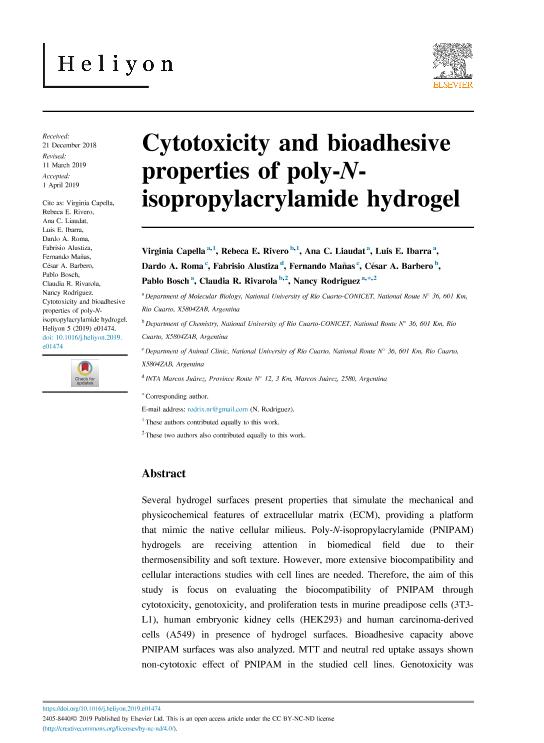Artículo
Cytotoxicity and bioadhesive properties of poly-N-isopropylacrylamide hydrogel
Capella, Virginia ; Rivero, Rebeca Edith
; Rivero, Rebeca Edith ; Liaudat, Ana Cecilia
; Liaudat, Ana Cecilia ; Ibarra, Luis Exequiel
; Ibarra, Luis Exequiel ; Roma, Dardo Andrés
; Roma, Dardo Andrés ; Alustiza, Fabrisio Eduardo
; Alustiza, Fabrisio Eduardo ; Mañas, Fernando Javier
; Mañas, Fernando Javier ; Barbero, César Alfredo
; Barbero, César Alfredo ; Bosch, Pablo
; Bosch, Pablo ; Rivarola, Claudia Rosana
; Rivarola, Claudia Rosana ; Rodriguez, Nancy
; Rodriguez, Nancy
 ; Rivero, Rebeca Edith
; Rivero, Rebeca Edith ; Liaudat, Ana Cecilia
; Liaudat, Ana Cecilia ; Ibarra, Luis Exequiel
; Ibarra, Luis Exequiel ; Roma, Dardo Andrés
; Roma, Dardo Andrés ; Alustiza, Fabrisio Eduardo
; Alustiza, Fabrisio Eduardo ; Mañas, Fernando Javier
; Mañas, Fernando Javier ; Barbero, César Alfredo
; Barbero, César Alfredo ; Bosch, Pablo
; Bosch, Pablo ; Rivarola, Claudia Rosana
; Rivarola, Claudia Rosana ; Rodriguez, Nancy
; Rodriguez, Nancy
Fecha de publicación:
04/2019
Editorial:
Elsevier
Revista:
Heliyon
ISSN:
2405-8440
Idioma:
Inglés
Tipo de recurso:
Artículo publicado
Clasificación temática:
Resumen
Several hydrogel surfaces present properties that simulate the mechanical andphysicochemical features of extracellular matrix (ECM), providing a platform that mimic the native cellular milieus. Poly-N-isopropylacrylamide (PNIPAM) hydrogels are receiving attention in biomedical field due to their thermosensibility and soft texture. However, more extensive biocompatibility and cellular interactions studies with cell lines are needed. Therefore, the aim of this study is focus on evaluating the biocompatibility of PNIPAM through cytotoxicity, genotoxicity, and proliferation tests in murine preadipose cells (3T3-L1), human embryonic kidney cells (HEK293) and human carcinoma-derived cells (A549) in presence of hydrogel surfaces. Bioadhesive capacity above PNIPAM surfaces was also analyzed. MTT and neutral red uptake assays shown non-cytotoxic effect of PNIPAM in the studied cell lines. Genotoxicity was evaluated by the single-cell gel electrophoresis assay, where DNA damages were not detected [3H]-thymidine staining allowed to corroborate that cell proliferation had progressed correctly. Adopted morphologies for each cell line over PNIPAM were similar to cell growing observed on polystyrene, indicating that the surfaces favor the cell attachment during 5 days´ culture. The good biocompatibility of PNIPAM surfaces make it an interesting scaffold withclinical potential in tissue regeneration engineering, and a possible adipose and kidney tissue-engineered construct.
Palabras clave:
PNIPAM SURFACES
,
2D SCAFFOLD
,
IN VITRO VALIDATION
,
CYTOTOXICITY
Archivos asociados
Licencia
Identificadores
Colecciones
Articulos(CCT - CORDOBA)
Articulos de CTRO.CIENTIFICO TECNOL.CONICET - CORDOBA
Articulos de CTRO.CIENTIFICO TECNOL.CONICET - CORDOBA
Citación
Capella, Virginia; Rivero, Rebeca Edith; Liaudat, Ana Cecilia; Ibarra, Luis Exequiel; Roma, Dardo Andrés; et al.; Cytotoxicity and bioadhesive properties of poly-N-isopropylacrylamide hydrogel; Elsevier; Heliyon; 5; 4; 4-2019
Compartir
Altmétricas



